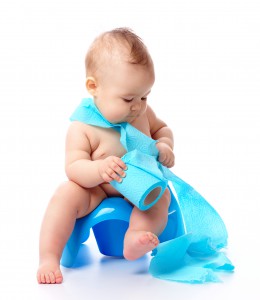We want to wait until our kids are ready before potty training, and we hear about 3-day potty training—but potty training expert, Jenny Phelps, cautions that trying to do both can really work against us. First, many parents trying waiting until their child is ready, without really knowing what ready looks like (follow that hyperlink, if you want more info on when kids are ready). They may think that “ready” means their child will show increasing interest in using the potty then eventually just start using it… and without realizing it, they’re kind of expecting their kids to potty train themselves. Then, when that doesn’t happen and they try a more proactive approach, they expect it to be done in three days. If they hit any snags along the way, they conclude their child probably wasn’t ready yet (and back to square one). Then, between reinforcing some of their child’s fears and waiting until they’re out of the ideal window for potty training, they may have an even harder time later.
Does all of this sound intimidating?
Fear not. Jenny Phelps—a Certified Potty Trainer and the owner of Oh Crap! Potty Training with Jenny—has graciously taken the time to walk us through some tips. Even if you have a good plan in place for how to potty train, there still are a few pitfalls worth knowing about, so that you can avoid them. Here, Jenny shares the most common potty training pitfalls, challenges and tips for successful potty training.
- Pee and poo in places other than the potty: Accidents are part of the process, so you can expect these going into potty training. When an accident happens, first, try to stay calm. Next, reinforce expectations by gently reminding your child that pee and poo go in the potty, not on the floor. Have them help to clean up, so that they learn that it’s easier to just go in the potty. Last, do your best to avoid shaming them (we want to avoid escalating pressure and resistance). Also, be careful not to make the clean-up too fun.
- Nervousness about pooping in the potty: Let’s be honest, we’ve all had to play “poop doula” at some point, holding our kid’s hands, looking them in the eyes, and telling them it will be OK, as they make their poop face, grunt, and sometimes even cry to us. So when they get nervous about pooping in a potty, it’s tempting to just put a diaper on and let them poop in there, if want to. But, Jenny cautions against this. “If they can request a diaper, they recognize the feeling, and they’re capable of putting it someplace else,” explains Jenny. “It’s easier to work through that fear now, than it is to reinforce it by continuing to put diapers on upon request, and then to try to work through it later.” Do you best to stay patient and supportive with poop, and expect that it may take a lot longer to learn, since kids don’t poop as often as they pee.
- Resistance to potty training: If a child is resistant to potty training, parents often interpret this as meaning they’re not ready. Toddlers are resistant to change though. Think back to other boundaries you’ve set (“honey, please don’t climb on the table…”). Most toddlers don’t agree to new boundaries, right away. Just try to stay consistent and you’ll get there.
- Timing that’s out-of-synch with the toddler’s needs: Jenny’s daughter once demanded that Jenny needed to pee. Jenny found herself immediately resisting, saying, “No I don’t”! And Jenny immediately recognized how being told to pee on cue can create resistance. So, to help prevent resistance, try to put your toddler on the potty when they’re ready to go, rather than at set time intervals.
- Unhelpful daycare: Many daycares don’t help with potty training, which can make potty training much harder for working parents. If this is your situation, you may want to carve out some time to do it yourself anyway. That way you can take care of potty training in a semi-low pressure situation, before you run up against preschool deadlines (especially if your preschool requires your kids to be potty trained).
- Unintentional pressure: Most kids get the basics within 3-7 days—but try to avoid potty training when you have a hard deadline in the immediate future, to alleviate some pressure.
- Too many bells and whistles: You don’t want a potty with too many bells and whistles, because you don’t want your child to become confused about what the potty is for. Likewise, sticker charts, bribes and reward systems may actually confuse your child, especially if they’re above your child’s level of understanding. Instead, try to think of potty training as setting a new expectation—pee and poo go in the potty—and continue to reinforce that message through the process.
Best of luck with potty training your little ones!
- – -
If you’d like to see more from Mama Lovejoy, you can follow this blog by liking Mama Lovejoy’s Facebook page. You can also subscribe to the Mama Lovejoy YouTube channel or you can find me @MamaLovejoy1 on Twitter, Instagram, Periscope or Tumblr.
This article is part of a series. Check out these articles for more information: 7 Signs Your Child Is Ready For Potty Training, How To Potty Train Your Child: 4 Steps To Ditching Diapers or these video interviews with Certified Potty Trainer, Jenny Phelps:
How Do I know When To Potty Train? (3 minutes)
How To Potty Train Your Child: Guidance From a Certified Potty Trainer (5 minutes)
Potty Training Troubleshooting and Pitfalls (7 minutes)
